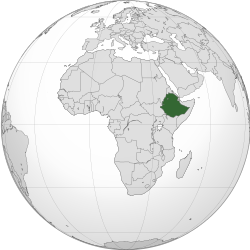Complete ecotouristic information database on national parks of Ethiopia.
Ethiopia is a country located in the Horn of Africa. It is bordered by Eritrea to the north and northeast,  Djibouti and Somalia to the east, Sudan and South Sudan to the west, and Kenya to the south. With over 93,000,000 inhabitants, Ethiopia is the most populous landlocked country in the world, and the second-most populated nation on the African continent. It occupies a total area of 1,126,829 square kilometres. Ethiopia is the world's 27th-largest country, comparable in size to Bolivia and its capital and largest city is Addis Ababa.
Djibouti and Somalia to the east, Sudan and South Sudan to the west, and Kenya to the south. With over 93,000,000 inhabitants, Ethiopia is the most populous landlocked country in the world, and the second-most populated nation on the African continent. It occupies a total area of 1,126,829 square kilometres. Ethiopia is the world's 27th-largest country, comparable in size to Bolivia and its capital and largest city is Addis Ababa.
You can find here the area with the oldest human settlement. It was probably in Ethiopia, where the „homo sapiens“ evolved. This country, unlike many others in Africa, does not share their colonial experience. It has (except for a short period of Italian occupation – 1 936 –
1 941) always been an independent country with very original and unique culture.
Within Ethiopia is a vast highland complex of mountains and dissected plateaus divided by the Great Rift Valley, which runs generally southwest to northeast and is surrounded by lowlands, steppes, or semi-desert. The great diversity of terrain determines wide variations in climate, soils, natural vegetation, and settlement patterns.
Ethiopia is an ecologically diverse country, ranging from the deserts along the eastern border to the tropical forests in the south to extensive Afromontane in the northern and southwestern parts. Lake Tana in the north is the source of the Blue Nile. It also has a large number of endemic species, notably the Gelada Baboon, the Walia Ibex and the Ethiopian wolf. The wide range of altitude has given the country a variety of ecologically distinct areas, this has helped to encourage the evolution of endemic species in ecological isolation.
The territory of Ethiopia is predominantly mountaineous, the Ethiopean highlands covers the majority of it. The east of the country is flat. The highest peak of Ethiopia is the Ras Dashen Terara Peak (4 620 m), the lowest place is the Danahil depression (- 125 m).
To a large extent, Ethiopia still remains an unexplored destination. Nature protection is here on quite a low level. In spite of this fact, some national parks, especially in the mountains – Semien, Bale Mountains, are unique not only because of their exceptional landscape but also due to many very rare and endemical plant and animal species. With their unique nature, these isolated mountain massives give the impression of „islands on the mainland“.
Although the infrastructure in Ethiopia is less developed than in Western countries, such a mysterious country in the heart of the „black continent“ is certainly worth exploring. The less tourists you meet here, the more memories you will bring home.
Detailed information on Ethiopia National Parks.
There is a database of this country national parks available. If you have any question or request you can send it by attached Informative Form.
Abiyatta - Shalla National Park, Awash National Park
Bale Mountains National Park
Gambella National Park
Harar Wildlife Sanctuary
Mago National Park
Nechi Sar National Park
Omo National Park
Semien Mountains National Park, Senkele Hartebeest Sanctuary
Yangudi Rassa National Park